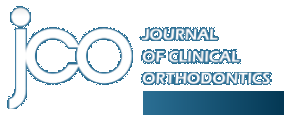Search Results For: 'cutting edge'
861.
Volume 41 : Number 9 : Page 563 : Sep 2007
In a 2001 article in this journal,1 we described how considerable improvement can be achieved in patients with missing lateral incisors by combining carefully detailed orthodontic space closure with t...
862.
2012 AAO CONVENTION
Volume 46 : Number 2 : Page 77 : Feb 2012
The Aloha State has not played host to the AAO since 2003, but its most wondrous attractions are timeless. As a preview of the annual meeting, to be held May 4-8, our yearly guide to attractions in th...
863.
2014 JCO Study of Orthodontic Diagnosis and Treatment Procedures, Part 1: Results and Trends
Volume 48 : Number 10 : Page 607 : Oct 2014
In this series of articles, we will report the key results of JCO's sixth nationwide Study of Orthodontic Diagnosis and Treatment Procedures. This year's Study is the first to be conducted online; the...
864.
Volume 34 : Number 12 : Page 723 : Aug 2000
Originally published in December 2000 The average orthodontist will move to a new office or do a major remodeling or redesign of an existing office two or three times during a career. An orthodontist'...
865.
Volume 57 : Number 8 : Page 436 : Aug 2023
Drs. Bashir, Azami, Uribe, and Safavi describe the management of missing teeth in growing patients. A careful selection of various modalities, including autotransplantation, tooth substitutions, and orthodontic space closure with skeletal anchorage, can achieve the best possible function, occlusion, and stability.
866.
Volume 13 : Number 6 : Page 390 : Jun 1979
JCO How do you evaluate a surgical-orthodontic case?DR. WOLK We get intraoral and extraoral photographs, tomograms, head films, panoramic and periapical x-rays, and models. The tomograms are valuable ...
867.
JCO ROUNDTABLE Early Orthodontic Treatment, Part 1
Volume 38 : Number 2 : Page 79 : Feb 2004
Editor's Note: Participants in the following discussion were selected from among respondents to JCO's quarterly Readers' Corner. DR. GOTTLIEB One of the great controversies in orthodontics today conce...
868.
JPO Interviews Dr. Irving D. Buchin
Volume 1 : Number 2 : Page 62 : Oct 1967
62-jco-img-0.jpgIrving Buchin is one of the world's most respected clinical orthodontists. He is an Instructor at the Tweed Foundation and Associate Professor of Orthodontics at the Boston University ...
869.
Success and Failure with the Positioner Appliance Report of 100 Cases
Volume 2 : Number 10 : Page 0 : Dec 1968
506-jco-img-0.jpgThe Tooth Positioner Appliance was originated by Dr. Harold Kesling of Westville, Indiana. The profession is indebted to Dr. Kesling for its development and for many of the refinement...
870.
Treatment Timing Onset or Onslaught?
Volume 5 : Number 4 : Page 191 : Apr 1971
Too often, discussions of treatment timing become debates about early treatment vs. late treatment when in truth, neither of these procedures exist as entities. We should be much ahead if we would ins...
871.
Borderline Extraction Cases, Part V: Panel Discussion (continued)
Volume 5 : Number 12 : Page 659 : Dec 1971
This is the final installment of the University of Pennsylvania Seminar Series. The Series appeared in the April through December issues of JCO. QUESTION FROM THE FLOOR: Dr. Swain, you did use edgewis...
872.
JCO Interviews Dr. Anthony A. Gianelly on the Direct Bonding of Plastic Brackets
Volume 7 : Number 2 : Page 95 : Feb 1973
Dr. Gianelly is Professor and Chairman, Department of Orthodontics, Boston University School of Graduate Dentistry, Boston, Massachusetts. He is co-author, with Dr. Henry Goldman, of the text ''Biolog...
873.
Volume 8 : Number 6 : Page 325 : Jun 1974
When Mrs. Lewis called our office to make an appointment for her daughter, Cathy, the conversation went something like this: "Dr. Sands' and Dr. Garrelick's office. Mrs. Gould speaking." "This is Mrs....
874.
Practical Points to Practice Efficiency, Part 1
Volume 9 : Number 8 : Page 473 : Aug 1975
The great challenge in orthodontics today is to produce quality orthodontics in a large practice. Most orthodontists gear their practices to treat those patients who seek their services. This requires...
875.
Bio-Progressive Therapy, Part 1: The Management Umbrella
Volume 11 : Number 9 : Page 616 : Sep 1977
Bio-Progressive Therapy is not strictly an orthodontic technique but, more importantly, it encompasses a total orthodontic philosophy. Bio-Progressive Therapy accepts as its mission the treatment of t...
876.
ORTHODONTIC OFFICE DESIGN
Volume 11 : Number 12 : Page 802 : Dec 1977
There is no such thing as an ideal floor plan. The ideal is always changing because a practice is a living, changing thing. An efficient floor plan for a new graduate will be outdated when he has a st...
877.
Volume 12 : Number 7 : Page 479 : Jul 1978
JCO Does Nitinol wire require fewer archwire changes than stainless steel wire?DR. CHANDA Nitinol wire requires fewer archwire changes in our initial alignments, but not in the finishing archwires.DR....
878.
Selecting an Orthodontic Computer System
Volume 16 : Number 8 : Page 524 : Aug 1982
In these challenging times, orthodontists must manage their practices more efficiently. That is why experts predict that the majority of orthodontic practices will install in-house computer systems du...
879.
JCO Interviews Robert J. Schulhof on Functional Appliance Results
Volume 17 : Number 2 : Page 125 : Feb 1983
GOTTLIEB Bob, in your article in the September issue of JCO entitled "Results of Class II Functional Appliance Treatment", you presented an analysis of the results of treatment with four functional ap...
880.
Preserving the Referral-Source Practice of Orthodontics
Volume 18 : Number 12 : Page 870 : Dec 1984
One of the consequences of the introduction of advertising and various alternate forms of delivery of dental care has been the division of orthodontic care between two groups with two different approa...
Showing 861-880 of 926 results. Search completed in 0.158 seconds.

